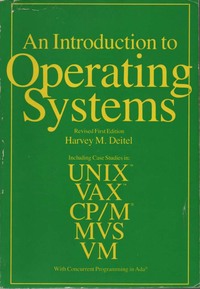An Introduction to Operating Systems (World Student S.) by Harvey M. Deitel (Author)
| Home > Browse Our Collection > Books > Miscellaneous > An Introduction to Op ... ey M. Deitel (Author) |
|
'An Introduction to Operating Systems, Revised First Edition, Including Case Studies in Unix, Vax, CP/M, MVS, VM, with concurrent Programming in Ada' Amazon Review: Unfortunately there are many more bad things to say about it. Let's face it, this subject is about as exciting as counting freckles. The baroque ugliness of the book's design, intended to suggest in appearance an old notebook of Leonardo da Vinci, has already been mentioned by other reviewers. It certainly doesn't make reading easier. The authors have tried to liven things up by including anecdotes, biographical sketches, mini-case studies, and other sidebar material. It's a good-hearted but wrong-headed effort. None of this material is necessary, and it only serves to make a long story longer. The book is over 1200 pages long. The last thing a college student needs in his backpack is more weight to carry around all day. And who's actually going to read this stuff? (Hmm, let's see... what to do with my study time? fix my data structures code? perpare for my Calc exam? no, I think I'll read some speculation about the origin of the word "glitch".) It isn't just the sidebar fluff that pads the book's length. A typical chapter finishes up with a two-page summary, four pages of glossary (unnecessary if you've read the chapter, where the terms are already defined and set in colored type), four pages of exercises , and four pages of bibliography. Yes, a bibliography is appended to each chapter. I am not talking a simple "suggested for further reading". I am talking works cited, 100 or more per chapter. In one case the bib is 13 pages long, with over 400 citations. Who is this for? How many undergraduate students are going to pursue these references? The makers of this book have employed some crafty strategies to pad their work. Likely to go unnoticed is the redundant fifty-page glossary at the very end of the book, in case you missed the ones at the end of each chapter. The book's table of contents is unnecessarily detailed, with an entry for chapter headings, subdivisions, sub-subdivisions, as well as each sidebar. Next comes a list of every illustration and code example. In case you need to find one fast, or something. There follows a twenty-page preface which details the book's features, and includes a "Tour of the Book", an overview of the eight parts and 21 chapters of the book. The book's actual text doesn't get started until 66 pages in. I'm guessing this sort of content goes over well with textbook committees, because it means they don't have to read the book to get a sense of its content. I can imagine no other reason to include it unless it is to drive up the price of the book. ISBN : 0201145022Publisher : Addison Wesley World Student Series Author : Harvey M. Deitel Format : Paperback; 700 pages This exhibit has a reference ID of CH6377. Please quote this reference ID in any communication with the Centre for Computing History. |










